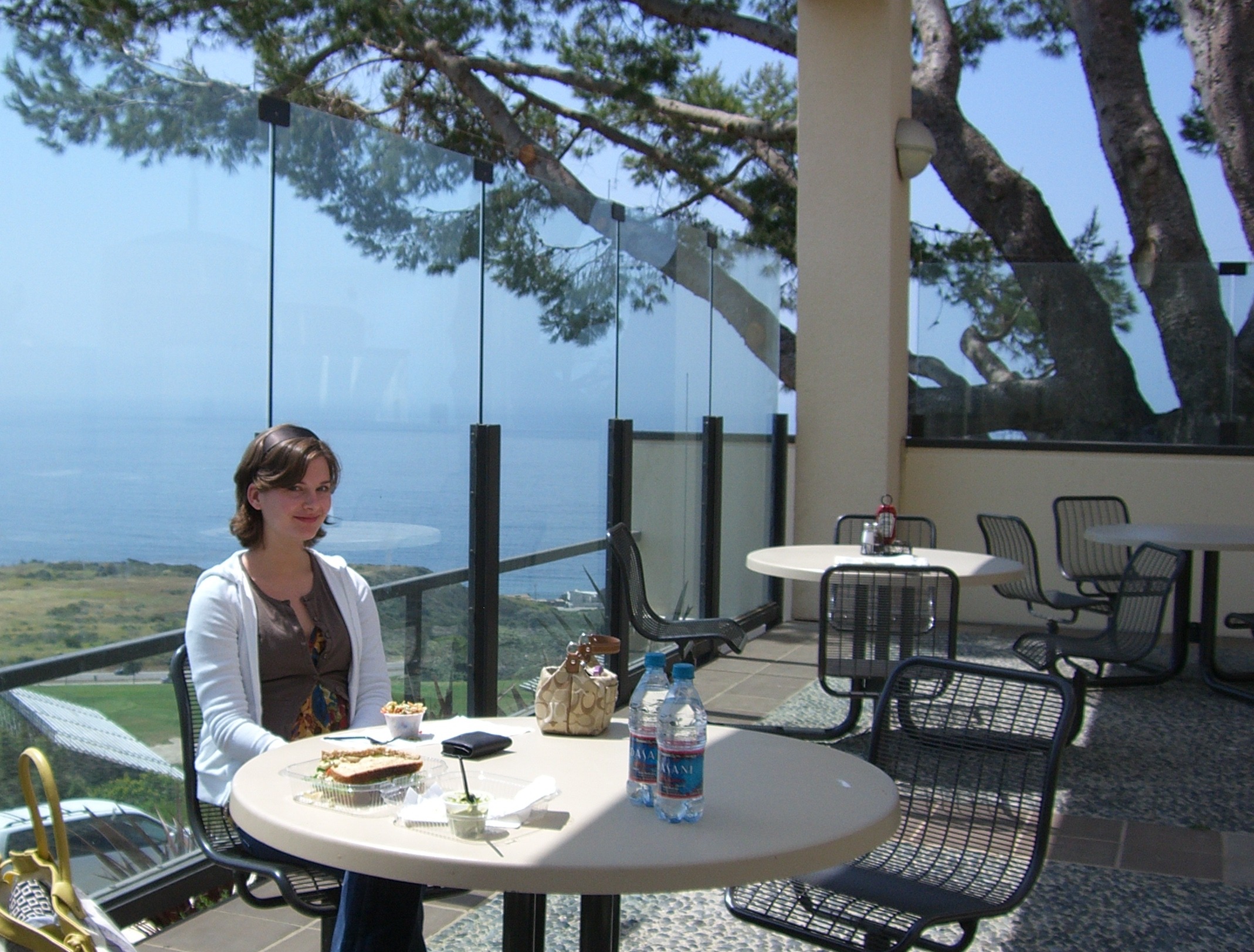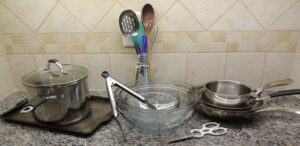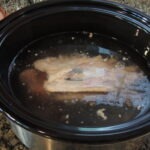Welcome to your new dorm room! Hopefully, you have everything you’ll need to survive in your new lodgings. You might even have a beautiful cafeteria with a wide assortment of food and an amazing ocean view…

Regardless of how nice your cafeteria appears, be forewarned: you will eventually tire of the choices. So, don’t let your family leave without taking you on one last shopping trip to the grocery store!
You’ll have plenty of opportunities to eat junk food between cafeteria offerings and snack bars, so we recommend stocking your kitchen space with a few healthful additions. Take a look at our College Students’ Guide: Top 20 Food Items below. The list reflects Rebecca and Greg’s favorites, so feel free to make some adjustments that better fit your taste preferences. We started with a concise list of our recommendations in alphabetical order, followed by details for each item.
(And don’t forget to ask your family to send care packages that could include some of the healthy snacks we’ve recommended below!)
Top 20 Food Items:
Non-perishables:
- Cereal and/or oatmeal
- Coffee/tea
- Crackers
- Granola and/or protein bars
- Honey (or other natural sweetener)
- Nuts and/or trail mix
- Olive oil and vinegar (or your favorite salad dressing)
- Smoothie mix
- Spices and seasonings
- Tuna and/or salmon (canned)
Perishables:
- Bread
- Cheese
- Condiments (mustard, mayonnaise, etc.)
- Fruit
- Hummus/dips
- Lunch meats
- Milk (cow, almond, coconut, soy, etc.)
- Nut butters
- Raw vegetables (carrot sticks, celery, etc.)
- Yogurt
MORE DETAILS
20 food items:
Non-perishables: (You do not need to store these in a refrigerator.)
- Cereal and/or oatmeal– The cafeteria will supply pre-sweetened and artificially flavored instant oatmeal and dry cereals for the most part. If you have a favorite healthy dry cereal, we suggest you stock up. You can also buy plain old-fashioned rolled oats, which cook quickly in a microwave and are more nutritious and cheaper than the little packets of instant oatmeal. Overnight Oats are another great option, since they don’t require any heat – just a refrigerator and some advance planning.
- Coffee/tea – It’s nice to make your own coffee or tea by boiling water in a microwave or electric kettle. Herbal teas are delicious and helpful for colds and other ailments common among college students. Ginger tea is a favorite for colds and digestion, peppermint for relaxation and digestion, echinacea for the immune system, and chamomile for relaxation and sleep.
- Crackers – When you’re craving something salty, whole grain (or gluten-free) crackers are a relatively healthy option. Read labels and choose crackers that have ingredients you recognize. At this time, there is no regulation for using the word “natural” on the label. It means nothing. Crackers with cheese or peanut butter are a quick and filling snack.
- Granola or protein bars –Watch out for high levels of sugar and calories. The label should indicate total grams of sugar from all sources. You can find good selections of protein bars at healthy grocery stores or even your local supermarket, Target, or Walmart, but compare prices. Sometimes it’s more expensive to buy healthy foods at your local grocery store than at health food stores. Better yet, ask your parents to include some in their care packages!
- Honey or other natural sweetener – Honey is easy to use, and it has some health benefits, as long as you buy raw and unfiltered honey. Avoid honey that has been heated and refined, since it no longer has the healthful enzymes, vitamins, and pollen that raw honey contains. We use honey on oatmeal, in plain yogurt, and to sweeten tea. Maple syrup can be used in the same way, but both are fairly expensive. Stevia is an all-natural zero calorie sweetener, although some people don’t care for the taste. You can find raw sugar that is not as refined as white sugar if you’d rather go that route. Look for words “sugar cane” or “cane” on the package to ensure that it is not made from genetically modified sugar beets. We try to avoid GMOs when possible, just to be on the safe side. In any event, use the smallest amount of sugar you need. Cutting sugar out of your diet will go a long way toward preventing the dreaded “Freshman 15.”
- Nuts and/or trail mix – Studies show that people who eat a small handful of nuts every day live longer and weigh less! Remember, that’s one small handful, not a whole jar! Beware of added oils, salt, and/or artificial ingredients. Look for raw or dry roasted nuts and avoid any that taste rancid or stale. Store in a cool place (like a refrigerator) after opening, to keep fresh. Trail mix is a high calorie snack, but still a healthier one than most. Read the ingredients and choose one with limited (or no) sugary additions like candies or yogurt-covered raisins.
- Olive oil & vinegar (or other dressing) – Extra virgin olive oil and your favorite vinegar is a healthier option than many of the dressings you’ll find in the cafeteria. A little oil and vinegar goes a long way, so purchase high quality. We like balsamic vinegar, but there are many others you might prefer. Take a salad back to your dorm room or sneak the oil and vinegar into the cafeteria, if you dare. (If you don’t like oil and vinegar, look for a more natural version of your favorite dressing, one with “real” ingredients you can pronounce.)
- Smoothie or protein mix – A smoothie or protein shake is a great way to start the day if you don’t have time to grab a hot breakfast. Although a fresh fruit smoothie is better, a mix is quicker and doesn’t require an electric blender. (However, we recommend getting an electric blender if you can. You can use it for mixes as well as whole fruit smoothies.) Some smoothie mixes are tastier and more nutritious than others, so get recommendations. If you don’t have a blender, get a bottle specifically designed for shaking up powdered mixes.
- Spices and seasonings – Salt and pepper alone can work wonders, but you should also have a few of your favorites spices on hand. We like cumin, oregano, chili powder, and cinnamon to name a few. There are also convenient mixes that can perk up a meal, like flavored Himalayan salt, Mrs. Dash, Herbamare, Gomasio, Za’atar, and garlic salt.
- Tuna and/or salmon, canned – Canned fish can be added to a salad from the cafeteria salad bar, or you can make a simple tuna salad in your room with mayonnaise and a chopped apple or celery.
Perishables: (You can keep some of these without refrigeration, until open.)
- Bread – Choose whole grains. Read labels and look for bread that says “100% WHOLE wheat” (or other grain). “Wheat flour” is just another name for white flour, and it has far fewer nutrients than whole grains. Usually, the “whole grain” breads offered in cafeterias only have a small amount of whole grain flour, which is why we like to buy our own 100% whole grain bread. If you follow a gluten-free regimen you will definitely need to buy your own bread. Rebecca eats mostly gluten-free, however, she can have small amounts of sprouted grain breads. The grains are sprouted before being ground, which increases protein levels and seems to change the gluten somewhat. Always refrigerate whole grain breads to prevent spoilage.
- Cheese – If you’re able to eat dairy without any digestive problems, cheese can be a quick protein-rich snack or even a light meal when combined with crackers and raw vegetables. Most hard cheeses last a fairly long time if they’re kept well-wrapped.
- Condiments – These include mustard, mayonnaise, ketchup, hot sauce, etc. We prefer Dijon mustard and mayonnaise made with olive oil, to use in our egg and tuna salads. Add Dijon to oil and vinegar for French Vinaigrette. Although there might be packets of ketchup or mayonnaise in the cafeteria, you can find more healthful versions at good grocery stores, and it might be worth it if you often make sandwiches in your dorm room. (Once again, read labels for ingredients!) Hot sauce can be used to jazz up just about anything from the cafeteria. It’s a low-calorie, low-salt way to add flavor to otherwise boring food. The question is, are you confident enough to carry some in your backpack to the cafeteria?
- Fruit – Even though the cafeteria will probably offer apples, oranges, and bananas, you might want to have a few other favorites around. Apples are sprayed with high levels of toxic chemicals, so we recommend buying organic ones if you can afford them. Otherwise, wash them well and peel them. Avocados are technically a fruit, so we include them here. They are an excellent source of healthy fats, phytochemicals, vitamins, and minerals, which can be added to sandwiches, salads, or smoothies.
- Hummus (or other dips) – We like bean-based dips because they’re rich in fiber, protein, and other nutrients that might be lacking in your regular diet. Eat these dips with raw veggies or crackers, or add some to a sandwich or salad. Read labels and find a brand that has ingredients you recognize (not chemicals). If you have a blender, you can easily make your own. See our recipes for Classic Hummus and other bean dips/spreads.
- Lunch meats – If you want to make your own sandwiches, you can find good quality lunch meats at the grocery or health food store. Choose meats that have no nitrates, preservatives, or gluten (often used as a filler). If you can afford it, look for organic meats, or at least those raised without hormones or antibiotics. More and more evidence shows that eating products made from animals grown in unsanitary conditions and fed antibiotics regularly can have negative effects on your immune system and overall health.
- Milk –Keep your favorite type of milk and/or cream around for coffee, tea, cereal, or oatmeal. Most types of milk can be purchased in a shelf-stable box (aseptic container) with no need to refrigerate until it’s open.
- Nut butters – (As long as you or your roommate are not allergic.) There are many different nut butters available now, although peanut butter is still the most economical. When selecting one, read the labels and look for brands with no added oils, sugars, fillers, flavorings, etc. The ingredient list should have only one or two items—nuts and perhaps salt. Natural nut butters usually separate (oil rises to the top), so you’ll need to stir them up then store them in the refrigerator. This is a high calorie snack, so use it sparingly. You can quickly pack on some extra pounds if you overdo it. However, a little nut butter is filling and provides protein that you might be missing, especially if you’ve decided to follow a vegetarian or vegan diet. Try nut butters with apple slices and celery sticks for extra fiber and vitamins.
- Raw vegetables (baby carrots, celery, cherry tomatoes) – These are a good low-calorie, yet highly nutritional snack to have around when you’re bored and just want to munch on something.
- Yogurt – Your cafeteria will probably have fruit yogurts that are loaded with sugar. By selecting plain yogurt you’ll have several possibilities. Mix some plain yogurt into a fruit yogurt to dilute the amount of sugar; add fresh fruit; or simply sweeten plain yogurt with a small amount of honey, sugar, or stevia. Greek yogurt is a good low-fat substitute for mayonnaise or sour cream as well.

